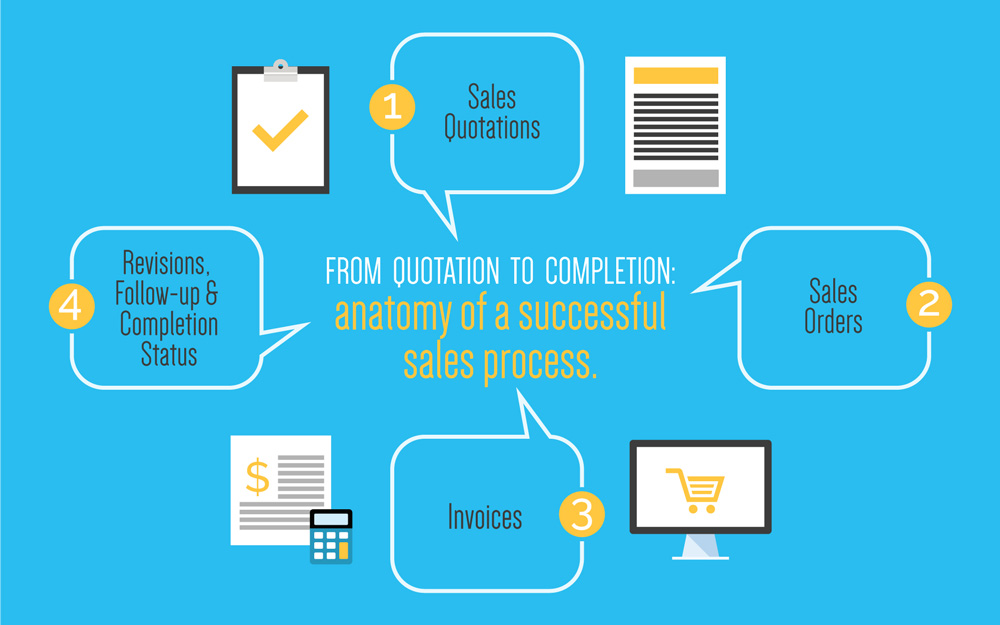Sales are the life and blood of your company, yet tracking and measuring them can be daunting. Using a clearly defined sales process will help you document your success and show you where your sales team is excelling and where it can improve. Here are the steps you should take:
Step 1. Sales Opportunity
This step is optional, but recommended, and is done to track and manage sales opportunities with the objective of converting the opportunities into Quotations. Sales opportunities normally track information such as client data, expected sales dates, expected sales size in dollar value, and other details such as the type of service or product to be sold.
Many companies do not track sales activities such as meetings, phone calls, emails, and other client interactions. ERP systems should allow you to track all activities and allow for detailed activity analysis from Sales Opportunity to Quotation to Order to Delivery to Invoice to Payment.
Step 2. Sales Quotation
A Sales quotation is a document that outlines the scope of work and payment modalities to agree upon before any transaction or service is performed. In many cases, it will serve as a roadmap for the collaboration of the parties, so make sure it is thoroughly completed
In addition to the Quotation reference, number, and Date, Quotations should include:
WHO - The WHO must contain all the information about the parties involved (including the salesperson or representative from your company and their counterpart from the client’s side). Clients are referred to as Business Partners and all their details should be added into the ERP database.
WHAT - The WHAT details how many items will be delivered, what services will be provided, in what quantity and at what prices. It also outlines the scope of work, which lets the client know what to expect. This part should answer questions such as “Is installation included?” or “What accessories come with the item?”
HOW - The HOW should include details such as the Location, type of Delivery, the terms of payments, the total after tax, return policy, validity of the quote (ex: 60 days), and any other comment you may have regarding the delivery of the product or service sold.
With the help of the ERP system, most details inserted at the quotation level should automatically flow into the Sales Order, Sales Delivery, Sales Invoice, and final Payment.
Step 3. Sales Order
Upon approval and signature of the Sales Quotation, it will turn into a Sales Order, which is a document that confirms the SALE and launches the delivery process. Sales orders should be assessed and planned, sometimes into multiple Deliveries.
Step 4. Sales Delivery
The delivery time depends on what items/services are being sold and could be instant like in apps and online software purchases or take minutes, days, months, or even years. Each item/service on the Sales Order may have its own time to deliver and it is important to assign a DATE to your delivery and manage it properly to ensure customer satisfaction.
Step 5. Sales Invoice
Invoices are generated after the work is done and delivered (even if partially). Once the client has the items/services delivered, your team can issue the invoices using the ERP system. Invoices should only be issued by authorised users since generating approved Invoices are automatically tied to accounting and will lead to the creation of journal entries; this in turn affects financial reports such as Profit & Loss and Balance Sheet which are what top management regularly monitors.
Step 6. Payment
Payment is the settlement of the amount either through cash, transfer, or credit. After the client pays the amount mentioned on the Invoice, the client will receive a printed receipt for the sum settled. Nowadays, the trend is to digitize receipts and allow for them to be sent automatically to the client’s email.
Analysis and Accountability
Using ERP, you can keep track of all activities, revisions, follow-ups, document statuses and their author/owner. Over time, it lets you pinpoint bottlenecks and see where your sales and after-sales processes can be optimized.
It may sound obvious but many businesses forget to update their documents such as status on their completed orders. How long did each order take? How many resources? Was it delivered late or on time? Keep an eye on your after-sales performance to maximize your results. Over time, this data will show you where your weak points are and where your team can improve. But don’t be mistaken, it doesn’t mean your team isn’t working well, it simply highlights the areas where they can improve to skyrocket your results.
This is a simple approach on sales process, but to each his own. You can adapt it to your business and vary the levels of complexity. But whatever model you use, don’t forget to centralize your data and look back on it after each sale and delivery.

